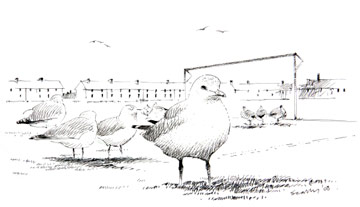Common Gull (Larus canus)

Common Gull © Ray Scally
Although widespread, reported from almost half of the county’s tetrads, the map shows Common Gulls to have a curious distribution. They were recorded all around the coast and estuaries, and tetrads within a few kilometres inshore, and quite widespread in agricultural land in southwest Cheshire. But the species was almost absent from a band running from Warrington through Knutsford to Congleton and sparsely distributed in the east of the county. Across Britain, they tend to avoid land above about 300 m (BTO Winter Atlas).
Their main food is earthworms, with other soil invertebrates found incidentally. At the coast, they mainly take molluscs. In some ways this seems to be the purest of the gulls, the one most apt to be feeding on natural foods and least likely to be scavenging the detritus of human life, but this Atlas survey showed no significant difference in habitat codes from Black-headed Gull. 53% of habitat records were farmland, with 8% in human sites and 19% on freshwater. The only differences from Black-headed Gull were that Common Gulls were less liable to be found on tilled or mixed farmland (8% of records compared to 13% for Black-headed Gull), and more likely to favour marine areas (14% of records compared to 9% for Black-headed Gull). In urban areas this is the gull most frequently using the closely-mown greenspace areas including playing-fields. The experience of Merseyside Ringing Group on visits to Warrington area landfill sites during the 1990s was that Common Gulls were seldom present, and could only reliably be expected during hard weather, and then only in small numbers compared to the other species. However, 1,250 Common Gulls were reported from the Gowy landfill site (SJ47G) during this Atlas survey.
Most Common Gulls were found in small groups, with a median flock size of 20 birds. Observers submitted 84 counts of 100 or more and ten counts of 1,000 or more birds. The largest was a flock of 3,500 counted by Neil Friswell on mainly flooded maize stubble near Pulford (SJ35U), with another big farmland gathering of 1,800 on a wet field at Tattenhall (SJ55E). The largest marine flocks were 3,000 on Hoylake shore (SJ28E/ 29A) and 1,800 in the Mersey night-time roost on Ince Banks (SJ47P).
Common Gulls wintering in the county originate from breeding grounds in Scotland and Fennoscandia. Birds have been found here that were ringed as chicks in Norway, Sweden, Finland and the Netherlands.
Sponsored by Esther Reinhard

